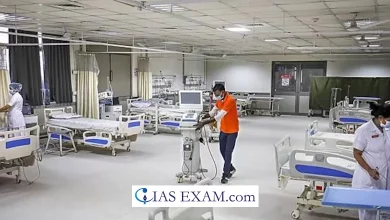Should State Govt. borrow more from the Centre?
GS Paper 3 - Indian Economy, Government Budgeting

Context
The Financial relations between the Union and various State Governments has been a matter of debate since long. Recently, the Govt. of Kerala has approached the Supreme Court for the resolution on how much can the State Government borrow from the market to bridge the excess of its expenditures over receipts. The Centre has stated that the borrowing should be limited to 3% of the State’s Income.
The discourse surrounding the question of whether state governments should amplify their borrowings from the Centre is multifaceted, eliciting a spectrum of opinions from stakeholders across the political and economic spectrum.
Source of Funds for State Governments
- Own State Revenues (State & Non-Tax)
- Transfers from Centre as shares of tax and grants
- Market Borrowings
Fiscal Demands for Extra Funds
- Increased Expenditure – In 2020-21, the Kerala government substantially raised its expenditure to 18% of its GDP to give economic assistance in the aftermath of the COVID-19 epidemic, supported by the loosening of borrowing limits then.
- Decline in Central Govt. Transfers to States – As ratios of GSDP, the Union government’s transfers to Kerala declined to 2.8% in 2023-24, significantly lower than previous years, even as the State’s revenues remained at around 8.0%.
- Uneven distribution of resources and revenue-sharing arrangements between the Centre and states. Despite being responsible for delivering essential public services and implementing centrally-sponsored schemes, state governments often find themselves inadequately funded, leading to disparities in development outcomes across regions.
- State governments often find themselves grappling with the challenge of balancing their expenditure needs with their limited revenue generation capacity, leading to calls for additional financial support from the Centre.
Socio-Economic Demands for Extra Funds
- India is characterized by significant regional variations in terms of income levels, infrastructure development, access to basic services, and socio-economic indicators.
- State governments, particularly those in economically backward regions, often require additional financial support from the Centre to bridge these disparities and promote balanced regional development.
- State governments face pressing socio-economic challenges such as poverty alleviation, unemployment, education, healthcare, and social welfare.
- Meeting these challenges requires substantial financial resources, and state governments often look to the Centre for assistance in funding key initiatives and programs.
- State governments also seek additional funds from the Centre to finance infrastructure projects and stimulate economic growth. Investments in infrastructure such as roads, railways, power plants, and irrigation facilities are critical for enhancing productivity, promoting industrialization, and attracting private investment.
- However, financing large-scale infrastructure projects often exceeds the fiscal capacity of state governments, necessitating financial support from the Centre.
- Many States including Kerala, face the challenge of an aging population which puts pressure on pension funds and healthcare systems, necessitating long-term financial planning and investment.
- The substantial outgo for pensions poses a financial burden on the state’s budget, requiring strategies for sustainable pension management to ensure fiscal stability.
Net Borrowing Ceilings
- The net borrowing ceiling for states in India denotes the maximum threshold set on the funds that state governments can borrow within a fiscal year. It helps in ensuring fiscal discipline and preventing states from accumulating excessive debt.
- The criteria for setting these limits are shaped by various factors such as inputs from the Finance Commission, the Fiscal Responsibility and Budget Management (FRBM) Act, and specific directives from the central government, notably the Ministry of Finance.
Basis of NBC and the FRBM Act
- Fiscal Responsibility Legislation: Both the central and state governments in India adhere to the FRBM Act, which establishes fiscal deficit goals to uphold fiscal discipline. Under the FRBM, states are required to maintain a fiscal deficit limit of 3% of the Gross State Domestic Product (GSDP).
- Central Government Guidelines: The central government, through the Department of Expenditure in the Ministry of Finance, sets the annual borrowing limits for each state based on a formula that considers the state’s GSDP, existing debt levels, fiscal discipline, and other relevant factors. These limits can be revised in response to special circumstances, such as natural disasters or significant economic downturns.
- Finance Commission Recommendations: The Finance Commission, which is constituted every five years, recommends how the central taxes are to be divided between the centre and the states and suggests measures to maintain fiscal stability. It also provides recommendations regarding the borrowing limits of states.
Way Forward
It is essential to consider various factors such as the fiscal capacity of state governments, their expenditure priorities, revenue generation capabilities, and the overall macroeconomic environment. The role of fiscal federalism and cooperative governance arrangements between the Centre and states must be taken into account to devise effective solutions that promote fiscal sustainability while addressing the developmental needs of states. Additionally, the States also need to put in place an effective forecasting and monitoring mechanism for cash inflows and outflows so that a need-based approach is followed for market borrowings and the interest cost of cash surpluses is minimized.
SOURCE: The Hindu





.png)



